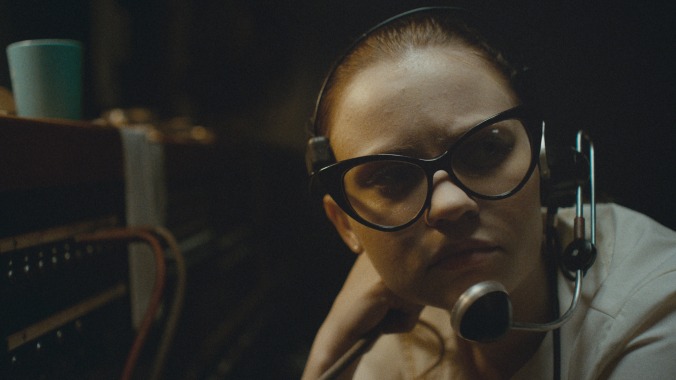A popular mantra in the digital era is “You have a smartphone, you have YouTube, no excuses.” But that’s only half the truth. The flip side to this new accessibility is that, while making a movie is easier than ever, it’s still difficult to stand out in an oversaturated media landscape. Just finishing the thing is an achievement, to be sure. But if you’re serious about getting it seen, you’ve got to understand both your strengths and your limitations and apply them in a way that will make your vision distinct. For an object lesson in the matter, aspiring filmmakers would do well to examine self-taught director Andrew Patterson’s debut feature, The Vast Of Night.
Set in the tiny border town of Cayuga, New Mexico (pop. 492) sometime in the 1950s, The Vast Of Night proceeds from an archetypical—some might even say clichéd—sci-fi premise. All you need to hear are the words “New Mexico” and “1950s” to figure out where the plot is headed, which does make its inevitable conclusion feel a little bit, well, inevitable. But that’s a minor issue, as the appeal of this story lies not in its twists and turns but its telling. Patterson, along with screenwriters James Montague and Craig W. Sanger, apply their influences and inspirations to The Vast Of Night in ingenious ways, making for a film that feels fresh despite being composed of classic elements.
Chief among these influences are sci-fi anthologies like The Twilight Zone, evoked here through a framing device that presents the story as an episode of a fictional series called Paradox Theater. Transitions to black-and-white and analog TV fuzz divide the film into acts, each combining Montague and Sanger’s dialogue-driven screenplay with Patterson’s ambitious camerawork. Despite its intergalactic scope, this is an intimate film, centering on wistful high schooler Fay (Sierra McCormick), a switchboard operator and amateur engineer, and her slightly older friend Everett (Jake Horowitz), a fast-talking radio DJ and fellow electronics nerd. While the rest of the town is preoccupied with a high school basketball game, Fay and Everett investigate a mysterious “something in the sky” spotted by the handful of townsfolk not at the gymnasium.
Early on, Fay’s trusty handheld recorder bounces against her hip as she and Everett walk the dusty, quiet streets, the camera following at their heels as they discuss the cutting-edge technologies Fay loves to read about in Popular Mechanics. (“Tiny TV phones? That’s cuckoo,” Everett tells her.) Then a strange sound interrupts Fay’s shift on the town’s telephone switchboard, leading first to an enigmatic man who calls in to Everett’s radio show claiming to know its origin, then to an elderly woman who says she’s seen the thing broadcasting this eerie frequency. Patterson keeps the camera tight on his actors’ faces as they tell (or listen to) these stories, beginning with an extended dialogue scene that’s much more compelling than you might think for a long, unbroken shot of a teenage girl moving circuits around on a switchboard.
Here, Patterson drops the picture out entirely—one of several moments that nod to the other major influence on The Vast Of Night’s storytelling: old-fashioned radio dramas. Much of the script would work just as well as a radio play, building unearthly atmosphere through dialogue and sound effects rather than action. It’s an appropriate device for a film that shows great affection for analog audio technology. But more importantly, it’s also a shrewd workaround for an indie production with a tiny effects budget.
What The Vast Of Night lacks in CGI spaceships, it makes up for in detailed mid-century atmosphere, cobbled together by diligent production designers making endless phone calls in and around Patterson’s native Oklahoma. (Similarly, the film was shot in a real small town, whose residents allowed the crew to treat their home like a backlot for the duration of the production.) It takes confidence to persuade collectors to let you borrow their precious vintage Chevrolets and reel-to-reel tape recorders—a quality that’s reflected in Patterson’s direction, which is remarkably assured for that of a newcomer, even before the jaw-dropping extended tracking shot midway through the film. And it’s in this place, at the intersection of ingenuity and determination, that The Vast Of Night announces itself as a film—and Patterson a filmmaker—to watch.


